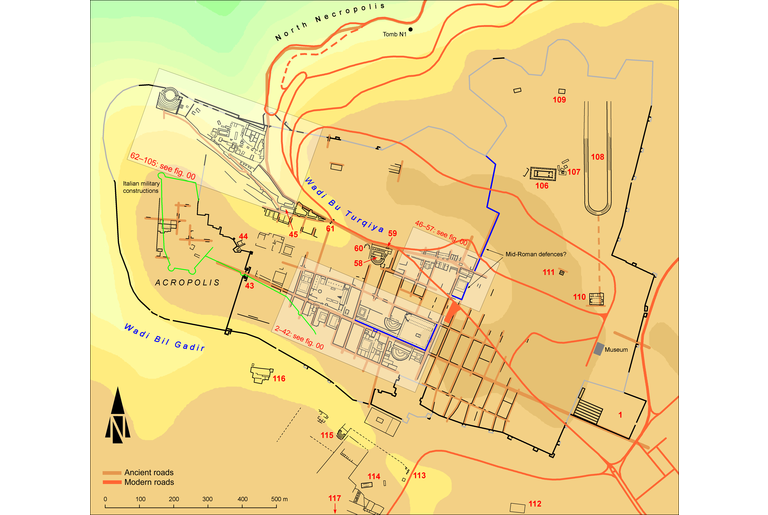Names, perhaps epitaph
IGCyr116400
Trismegistos ID: 738713
Source Description
Repository
Cyrene Museum, Storeroom of the American excavations, 69.208; 74-91.
Support
Lower part of a marble stele with all edges chipped (0.405; 0.62;0.215).
Layout
Inscribed on the very worn face.
Letters
0.018; uneven lineation.
Place of Origin
Date
Perhaps third century B.C. (lettering)
Findspot
Found in 1974 by the American team of D. White at Cyrene pleiades; HGL : Enclosed sanctuary of Demeter and Kore , area 2, 1.2.
Present Location
Not seen by IGCyr team.
Text constituted from
Transcription from editor.
Bibliography
Reynolds, 2012 Reynolds, J.M., 2012, Appendix: the inscriptions on stone and lead, in D. White (ed.), The extramural sanctuary of Demeter and Persephone at Cyrene, Libya, final reports VIII: the sanctuary’s imperial architectural development, conflict with Christianity, and final days, Philadelphia - see in bibliography , n. A.8 (no image) , and Dobias-Lalou, Bulletin Épigraphique Dobias-Lalou, C.Bulletin Épigraphique in Études Grecques (REG)1987- - see in bibliography , 2013.480, whence SEG Supplementum Epigraphicum Graecum, Leiden, then Amsterdam, 1923-1971, then 1979- - see in bibliography , 62.1791.
Text
Apparatus
1a
Reynolds, 2012
Reynolds, J.M., 2012, Appendix: the inscriptions on stone and lead, in D. White (ed.), The extramural sanctuary of Demeter and Persephone at Cyrene, Libya, final reports VIII: the sanctuary’s imperial architectural development, conflict with Christianity, and final days, Philadelphia - see in bibliography
(vac. 2 lines) : Reynolds, 2012
Reynolds, J.M., 2012, Appendix: the inscriptions on stone and lead, in D. White (ed.), The extramural sanctuary of Demeter and Persephone at Cyrene, Libya, final reports VIII: the sanctuary’s imperial architectural development, conflict with Christianity, and final days, Philadelphia - see in bibliography
[------] | [------]
2
Reynolds, 2012
Reynolds, J.M., 2012, Appendix: the inscriptions on stone and lead, in D. White (ed.), The extramural sanctuary of Demeter and Persephone at Cyrene, Libya, final reports VIII: the sanctuary’s imperial architectural development, conflict with Christianity, and final days, Philadelphia - see in bibliography
Φιλείας Χαρίνω Ν : Reynolds, 2012
Reynolds, J.M., 2012, Appendix: the inscriptions on stone and lead, in D. White (ed.), The extramural sanctuary of Demeter and Persephone at Cyrene, Libya, final reports VIII: the sanctuary’s imperial architectural development, conflict with Christianity, and final days, Philadelphia - see in bibliography
φιλείας χάριν ΩΝ
2a
Reynolds, 2012
Reynolds, J.M., 2012, Appendix: the inscriptions on stone and lead, in D. White (ed.), The extramural sanctuary of Demeter and Persephone at Cyrene, Libya, final reports VIII: the sanctuary’s imperial architectural development, conflict with Christianity, and final days, Philadelphia - see in bibliography
(vac. 4 lines) : Reynolds, 2012
Reynolds, J.M., 2012, Appendix: the inscriptions on stone and lead, in D. White (ed.), The extramural sanctuary of Demeter and Persephone at Cyrene, Libya, final reports VIII: the sanctuary’s imperial architectural development, conflict with Christianity, and final days, Philadelphia - see in bibliography
[------] | [------] | [------] | [------]
3
Reynolds, 2012
Reynolds, J.M., 2012, Appendix: the inscriptions on stone and lead, in D. White (ed.), The extramural sanctuary of Demeter and Persephone at Cyrene, Libya, final reports VIII: the sanctuary’s imperial architectural development, conflict with Christianity, and final days, Philadelphia - see in bibliography
(vac.) : Reynolds, 2012
Reynolds, J.M., 2012, Appendix: the inscriptions on stone and lead, in D. White (ed.), The extramural sanctuary of Demeter and Persephone at Cyrene, Libya, final reports VIII: the sanctuary’s imperial architectural development, conflict with Christianity, and final days, Philadelphia - see in bibliography
[---]
French translation
[Untel] fils d'Athènagoras. Phileias fils de Kharinos N [---] . PH. Pélagôn fils de Philippos.
English translation
[So-and-so] son of Athenagoras. Phileias son of Charinos N [---] . PH. Pelagon son of Philippos.
Italian translation
[Il tale] figlio di Athenagoras. Phileias figlio di Charinos N [---] . PH. Pelagon figlio di Philippos.
Commentary
Although found in the sanctuary of Demeter and Kore, this stone has certainly been brought there from elsewhere. Rather than a list of officials of some kind, it seems more plausible that it was a funerary stele brought from the nearby West Necropolis. A photograph of the stone would help to push or reject this view.
At line 2, we prefer to read personal names rather that Reynolds' alternative suggestion of the formula meaning 'for the sake of friendship', which is attested much later. The last preserved letter nu might be the beginning of νέος, rather than the numeral 50 giving the age (as suggested by Dobias-Lalou, Bulletin Épigraphique Dobias-Lalou, C.Bulletin Épigraphique in Études Grecques (REG)1987- - see in bibliography 2013.480), for this feature is also later.
At line 3, Reynolds could see no letter after the phi. The surface might be much worn out or the letter was cut independently of the rest.
Creative Commons Attributions-NonCommercial 4.0 International License.
All citation, reuse or distribution of this work must contain a link back to DOI: http://doi.org/10.6092/UNIBO/IGCYRGVCYR and the filename (IGCyr000000 or GVCyr000), as well as the year of consultation.
